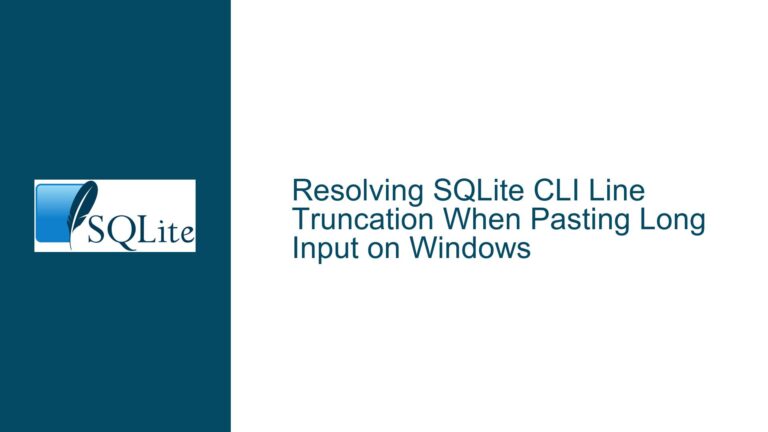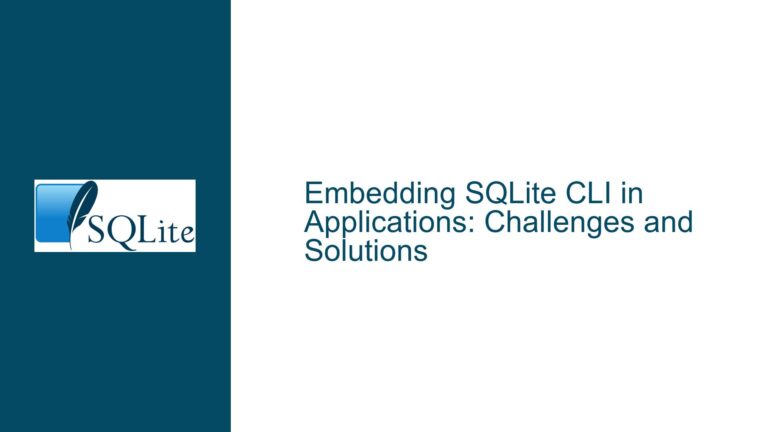Compiling SQLite Extensions at Build Time Without .load Commands
Integrating SQLite Extensions During Compilation
When working with SQLite, one of the most powerful features is its extensibility through custom extensions. These extensions can add new functions, virtual tables, or even entirely new behaviors to the SQLite engine. However, a common challenge arises when developers want to include these extensions at compile time, rather than loading them dynamically at runtime using the .load command in the SQLite shell or configuring ~/.sqliterc. This post will delve into the intricacies of integrating SQLite extensions during the compilation process, exploring the underlying mechanisms, potential pitfalls, and step-by-step solutions to achieve this seamlessly.
Understanding the Core Mechanisms of SQLite Extension Integration
SQLite extensions are typically implemented as shared libraries (e.g., .so files on Linux or .dll files on Windows) that can be loaded into the SQLite environment at runtime. However, for scenarios where runtime loading is undesirable or impractical, integrating extensions directly into the SQLite binary at compile time is a viable alternative. This approach requires a deep understanding of SQLite’s build system, its source code structure, and the specific hooks available for extension initialization.
The primary mechanism for integrating extensions at compile time involves modifying the SQLite source code, specifically the src/shell.c.in file, which serves as the template for generating the SQLite shell executable. This file contains the initialization logic for the SQLite shell, including the setup of built-in extensions. By adding custom extension initialization code to this file, developers can ensure that their extensions are automatically loaded when the SQLite shell is started, without the need for explicit .load commands.
Another approach involves using the SQLITE_EXTRA_INIT compile-time option, which allows developers to specify a custom initialization function that will be called during SQLite’s startup sequence. This method is more flexible and less intrusive than modifying the src/shell.c.in file, as it does not require changes to the SQLite source code itself. However, it is also less documented and may require additional effort to implement correctly.
Potential Challenges and Considerations
Integrating SQLite extensions at compile time is not without its challenges. One of the primary concerns is ensuring that the extension initialization code is correctly integrated into the SQLite build system. This requires a thorough understanding of the build process, including the role of the Makefile, configure scripts, and other build tools. Missteps in this area can lead to build failures or runtime errors that are difficult to diagnose.
Another consideration is the potential impact on the SQLite binary’s size and performance. Including additional extensions at compile time can increase the size of the resulting binary, which may be a concern for resource-constrained environments. Additionally, the initialization of multiple extensions during startup can introduce latency, particularly if the extensions perform complex setup operations.
Compatibility with different versions of SQLite is also a critical factor. The SQLite source code and build system evolve over time, and changes in newer versions may affect the way extensions are integrated. Developers must ensure that their modifications are compatible with the specific version of SQLite they are targeting, and be prepared to adapt their approach as needed.
Step-by-Step Guide to Integrating SQLite Extensions at Compile Time
To successfully integrate a SQLite extension at compile time, follow these detailed steps:
Obtain the SQLite Source Code: Begin by obtaining the latest version of the SQLite source code from the official SQLite website or GitHub repository. This will provide you with the necessary files and build scripts to compile SQLite with your custom extensions.
Identify the Extension Initialization Function: Each SQLite extension typically provides an initialization function that must be called to register the extension’s functionality with the SQLite engine. This function is usually named something like
sqlite3_extension_initand is defined in the extension’s source code. Locate this function and note its signature and any required parameters.Modify
src/shell.c.in: Open thesrc/shell.c.infile in a text editor and locate the section where other extensions are initialized. This is typically around line 4767, as mentioned in the discussion. Add a call to your extension’s initialization function in this section, ensuring that it follows the same pattern as the existing initialization calls. For example:#ifdef SQLITE_HAVE_MY_EXTENSION extern int sqlite3_my_extension_init(sqlite3*, char**, const sqlite3_api_routines*); sqlite3_my_extension_init(db, 0, 0); #endifThis code snippet assumes that your extension’s initialization function is named
sqlite3_my_extension_initand that you have defined a preprocessor macroSQLITE_HAVE_MY_EXTENSIONto conditionally include the extension.Update the Build Configuration: Modify the SQLite build configuration to include your extension’s source code and any necessary compilation flags. This typically involves editing the
Makefileorconfigurescript to add the appropriate source files and define any required preprocessor macros. For example:CFLAGS += -DSQLITE_HAVE_MY_EXTENSION SRC += path/to/my_extension.cThis ensures that your extension’s source code is compiled and linked into the SQLite binary.
Compile SQLite: Run the build process to compile SQLite with your custom extension. This typically involves executing
makeor a similar command, depending on your build environment. Ensure that the build completes successfully and that the resulting SQLite binary includes your extension.Verify Extension Integration: Start the SQLite shell and verify that your extension is automatically loaded and functioning as expected. You can do this by executing SQL commands that rely on your extension’s functionality or by querying the
sqlite_mastertable to confirm that any new virtual tables or functions have been registered.Handle Potential Issues: If you encounter any issues during the build or runtime, carefully review the error messages and logs to identify the root cause. Common issues include missing dependencies, incorrect function signatures, or conflicts with other extensions. Address these issues by making the necessary adjustments to your code or build configuration.
Alternative Approach: Using SQLITE_EXTRA_INIT
For developers who prefer not to modify the src/shell.c.in file, the SQLITE_EXTRA_INIT compile-time option provides an alternative method for integrating extensions at compile time. This approach involves defining a custom initialization function that will be called during SQLite’s startup sequence. Here’s how to implement this:
Define the Custom Initialization Function: Create a new source file (e.g.,
my_extension_init.c) and define a function that initializes your extension. This function should have the following signature:int sqlite3_my_extension_init(void);Inside this function, call your extension’s initialization function and perform any other necessary setup.
Update the Build Configuration: Modify the SQLite build configuration to include your custom initialization function and define the
SQLITE_EXTRA_INITmacro. For example:CFLAGS += -DSQLITE_EXTRA_INIT=sqlite3_my_extension_init SRC += path/to/my_extension_init.cThis tells the SQLite build system to call your custom initialization function during startup.
Compile SQLite: Run the build process to compile SQLite with your custom initialization function. Ensure that the build completes successfully and that the resulting SQLite binary includes your extension.
Verify Extension Integration: Start the SQLite shell and verify that your extension is automatically loaded and functioning as expected. As with the previous method, you can execute SQL commands or query the
sqlite_mastertable to confirm that your extension has been integrated correctly.
Best Practices and Recommendations
When integrating SQLite extensions at compile time, it is important to follow best practices to ensure a smooth and maintainable process:
Modularize Your Code: Keep your extension’s source code and initialization logic separate from the SQLite source code. This makes it easier to update or replace your extension without affecting the core SQLite build.
Use Conditional Compilation: Use preprocessor macros to conditionally include your extension based on build configuration options. This allows you to easily enable or disable your extension without modifying the source code.
Test Thoroughly: Test your extension in various environments and with different versions of SQLite to ensure compatibility and stability. Pay particular attention to edge cases and error conditions.
Document Your Changes: Document any modifications you make to the SQLite source code or build configuration. This will help other developers understand your changes and make it easier to maintain your code in the future.
Consider Runtime Loading: While integrating extensions at compile time can be advantageous in some scenarios, consider whether runtime loading might be a better fit for your use case. Runtime loading offers greater flexibility and can simplify the build process.
Conclusion
Integrating SQLite extensions at compile time is a powerful technique that can enhance the functionality of the SQLite engine without requiring runtime loading. By understanding the underlying mechanisms, potential challenges, and best practices, developers can successfully integrate custom extensions into their SQLite builds. Whether you choose to modify the src/shell.c.in file or use the SQLITE_EXTRA_INIT compile-time option, careful planning and thorough testing are key to achieving a seamless integration. With the detailed steps and recommendations provided in this guide, you should be well-equipped to tackle this advanced SQLite development task.






